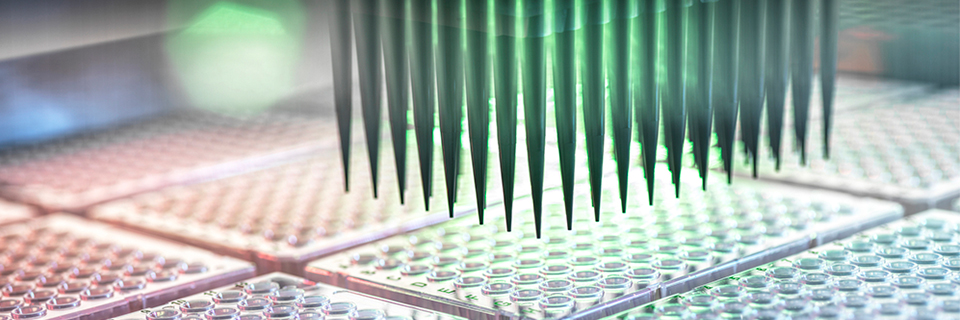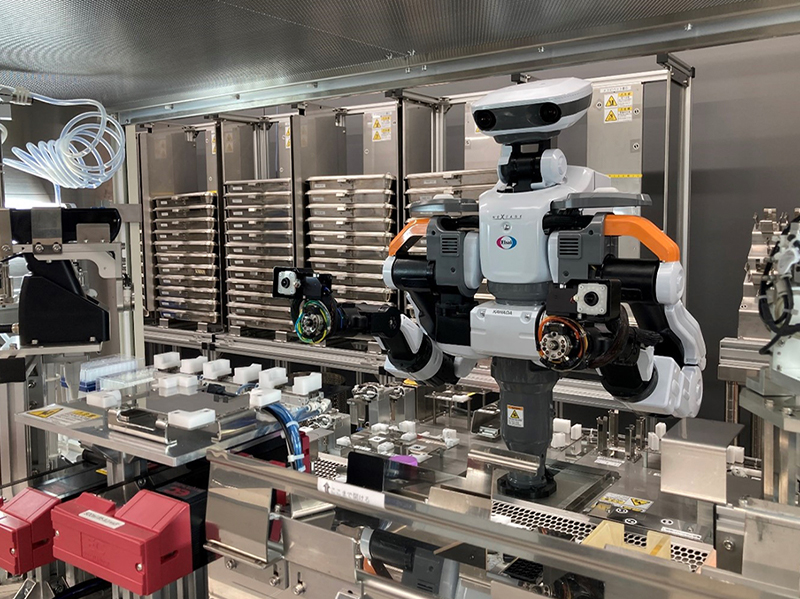
In recent years, utilization of AI technology to increase the accuracy of drug discovery research has been attracting great attention. Since AI requires a large amount of highly accurate and precise data to improve its prediction, there are high expectations for robots which can accurately and continuously generate large amounts of high-quality experimental data. With the use of robots, experimental protocols that have so far been performed by researchers can be replaced by robot programs, and all experimental results can be recorded as digital data. The use of robots can also contribute to an improvement in reproducibility, data integrity and data utilization of experiments. As part of our digital transformation (DX) efforts, Eisai is conducting drug discovery research utilizing a wide variety of robots, from robots that perform simple reagent dispensing to those that perform experiments with more complex multiple processes.
Robots in High-Throughput Screening
For more than 25 years, Eisai's drug discovery research has been engaged in high-throughput screening (HTS), which identifies active compounds as new drug candidates from a huge number of compounds. At Eisai, robot utilization has been promoted together with HTS to manage and evaluate huge number of compounds that are impossible to handle manually. HTS simplifies and miniaturizes experiments as much as possible to the size of a standardized microplate, which allows a dedicated robot to dispense, transport and measure reagents accurately at high speed. In addition, by linking these devices and controlling the time of each process, a large amount of data can be obtained efficiently without human intervention. The HTS data that Eisai has accumulated so far is a useful and unique asset and we are utilizing these data to promote new drug discovery projects by applying this HTS data to AI. Application of these robots is not limited to HTS, as we are also using them for small-scale drug discovery experiments. Experiments on the nanoliter (one billionth of 1 liter) scale, which are difficult to handle manually, are becoming more common, and new applications, such as evaluation of valuable and rare samples are becoming apparent.
Experimental Robots that Emulate Skilled Researchers
Compounds identified by HTS and newly synthesized compounds based on them must be examined in detail for their suitability as new drug candidates. Compared to HTS, which has many uniform experiments, the subsequent evaluation of compounds differs depending on the target physiological phenomena and diseases to be treated, and involves many complicated experiments that require the delicate movements of a skilled researcher. For these reasons, the use of robots has lagged behind. Therefore, Eisai took on the challenge of developing experimental robots that can handle complex experiments by introducing highly flexible robots to its research laboratories, which have been used in manufacturing factories in recent years. Together with robot integrator Hitachi High-Tech Corporation, we have developed and utilized the experimental robot “ICHIRO”, which is equipped with a dual-arm human-collaborative robot NEXTAGE® (a registered trademark of Kawada Robotics Corporation) and is mounted on an automatic guided vehicle. ICHIRO moves around in laboratory and uses the same experimental equipment as the researchers to emulate their experiments by utilizing its high-precision image recognition with four cameras, and 15 types of hand parts. Currently, a series of cell culture experiments, such as cell passaging and medium exchange, which are necessary for evaluating bioactivity, are performed continuously over several hours with accuracy equal to or better than that of skilled researchers. Experimental robot technology is still in the process of development and there are many challenges unique to life science experiments that are different from those in manufacturing. Eisai hopes to realize efficient drug discovery by promoting the use of robots at research laboratories and further promoting DX by leveraging the know-how gained through the development of ICHIRO.

